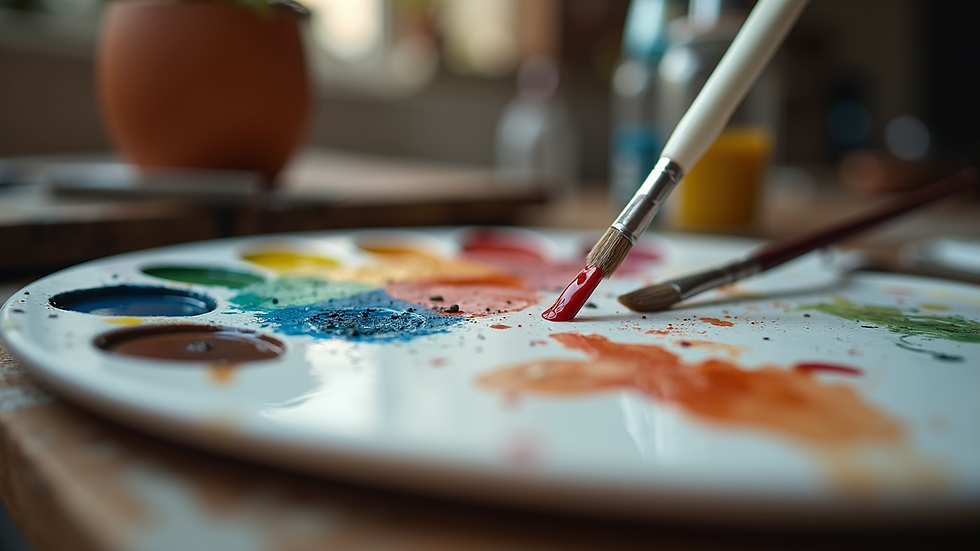- Ayal Armon
- Dec 9
- 4 min read
Painting natural landscapes in oil is like trying to catch a breeze in a jar. It’s elusive, beautiful, and sometimes downright frustrating. But hey, that’s what makes it fun, right? I’ve spent countless hours with my brushes, palette, and a stubborn canvas, trying to capture the magic of trees, skies, and rolling hills. Today, I want to share some of the techniques that have helped me turn those frustrating moments into paintings I’m proud of.
Getting Started with Landscape Painting Techniques
Before you dive headfirst into your oil paints, it’s good to have a game plan. Landscape painting isn’t just about slapping green and blue on a canvas and hoping for the best. Nope, it’s about understanding light, color, and texture. Here’s how I approach it:
Start with a sketch: I usually do a quick pencil or charcoal sketch to map out the main elements. This saves me from panicking halfway through when I realize the tree is the size of a skyscraper.
Choose your color palette wisely: Nature has a vast range of colors, but you don’t need to use them all. Pick a limited palette that reflects the mood you want—warm and sunny or cool and misty.
Block in large shapes first: Don’t get caught up in details too early. Lay down the big shapes and colors to establish the composition.
Work from dark to light: Oils are great for layering. Start with darker tones and gradually add lighter highlights.
These basics set the stage for more advanced techniques that bring your landscape to life.

Essential Landscape Painting Techniques for Depth and Texture
Now, let’s get into the juicy stuff. How do you make a flat canvas feel like a three-dimensional world? Here are some tricks I swear by:
1. Atmospheric Perspective
This is a fancy term for making distant objects look hazy and less detailed. It’s all about mimicking how the atmosphere affects what we see. To do this:
Use cooler, lighter colors for distant hills or mountains.
Soften edges and reduce contrast as things recede.
Add a slight bluish or grayish tint to faraway objects.
This technique tricks the eye into seeing depth, making your landscape feel vast and real.
2. Impasto for Texture
Impasto means applying paint thickly so it stands out from the canvas. It’s perfect for rough tree bark, rocky surfaces, or thick grass. I love using a palette knife or a stiff brush to create this effect. It adds a tactile quality that invites viewers to almost feel the landscape.
3. Glazing for Luminosity
Glazing involves applying thin, transparent layers of paint over dry layers. It’s like adding a colored filter that makes your painting glow from within. I use glazing to enhance skies or water reflections, giving them a shimmering, almost magical quality.
4. Dry Brush for Fine Details
When you want to add delicate details like blades of grass or twigs, dry brushing is your friend. Use a brush with very little paint and drag it lightly over the surface. It creates a scratchy, textured effect that’s perfect for subtle details.
These techniques, combined, help create landscapes that feel alive and inviting.

My Go-To Tools and Materials for Landscape Painting
I’m a bit of a gear nerd, so I can’t resist sharing what I use. The right tools make a huge difference, especially when working with oils.
Brushes: I keep a mix of flats, rounds, and filberts. Flats are great for blocking in shapes, rounds for details, and filberts for soft edges.
Palette knives: These are essential for impasto and mixing colors. Plus, they’re fun to use when you want to feel like a paint-slinging cowboy.
Canvas: I prefer stretched linen for its durability and texture, but cotton works fine too.
Mediums: Linseed oil and turpentine help control drying time and paint consistency. I’m careful not to overdo it, or my painting turns into a sticky mess.
Palette: A wooden or glass palette works well. I like glass because it’s easy to clean and doesn’t stain.
Having the right materials means fewer headaches and more time enjoying the painting process.
Tips for Capturing Light and Color in Natural Landscapes
Light is the secret sauce of any great landscape. Without it, your painting looks flat and lifeless. Here’s how I try to capture that elusive glow:
Observe, then paint: Spend time outside watching how light changes throughout the day. Notice how shadows shift and colors change.
Use complementary colors: Placing colors opposite each other on the color wheel (like orange and blue) makes your painting pop.
Mix your own greens: Nature’s greens are rarely just green. Mix blues, yellows, and even reds to get realistic foliage colors.
Highlight reflections: Water and wet surfaces reflect light differently. Use softer edges and lighter tones to show reflections.
Don’t be afraid of shadows: Shadows add drama and depth. Use cool colors for shadows to contrast with warm light areas.
These tips help me bring a sense of time and place to my landscapes.
Why I Love Sharing My Journey and Art with You
Painting landscapes in oil is more than just a hobby for me. It’s a way to connect with the world and with people who appreciate art’s unique power. Sharing my work and techniques feels like inviting you into my studio, even if it’s just through words and pictures.
If you want to explore more about oil painting techniques for landscapes, I highly recommend checking out resources that dive deeper into this beautiful craft. Whether you’re an art collector, interior designer, or just someone looking for a unique gift, there’s something special about owning a piece of nature captured in oil.
Thanks for hanging out with me today. Now, go grab your brushes and start painting your own slice of the great outdoors!




